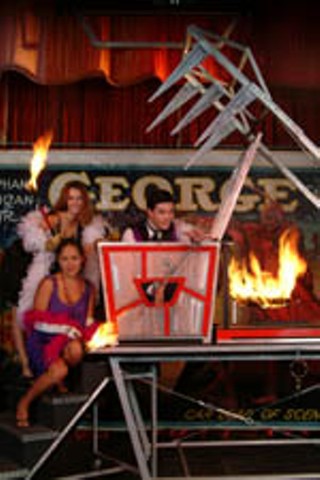Sharpening the Claw
By Robert Faires, Fri., Sept. 5, 2003

"Tonight I would like to tell you the story of George, the world's second greatest magician. It was the year 1927, the time of the first automobiles and the great Harry Houdini. Houdini had just invented his infamous Water Torture Cell illusion and was touring the country to thunderous applause, and the rest of the magicians were trying desperately to find something that would outdo the great Houdini. That's when our friend George had an inspired idea, and he called it 'the Claw.'"
Thus begins Ray Anderson's introduction to his latest illusion at Esther's Follies, an elaborate escape routine involving handcuffs, a burning rope, and a large metal arm studded with steel spikes that will puncture poor Anderson if he isn't able to get clear of it in less than a minute. Anderson is continually expanding his repertoire of illusions, but just adding one trick may take him four to eight months of planning, design, and rehearsal. How he came to add the Claw provides some insight into the working process of the amazing Ray.
"I've always thought escapes were really hokey," Anderson confesses, "and everybody does them, and it's all real serious, and it really wasn't my style. But I'm always looking for something new, and I've done so many things that now it has become difficult to find new illusions to do. So I finally decided I would try one of these."
He began by shopping around for escapes, something that magicians are able to do. "I was looking for something that was not the typical things that you've seen a million times and that was a little fun, and I came across this illusion that was built by a builder I'd never used before. There are illusion-builders in the country, and most of my illusions are built by the same people who build for, like, Siegfried and Roy. It wasn't always that way with me, because they're very expensive, but I try to get the best quality props that I can afford. This was a new guy, and this was his top-of-the-line prop."
The Claw appealed to Anderson on several fronts: It had the element of danger he was looking for, and the complexity of the piece was attractive visually -- "just the prop itself looks kind of like a mousetrap," he says -- and in terms of the illusion's execution. He would need the assistance of several members of the Follies cast (always a plus) and time to set it all up: explaining the trick, getting locked in the box, setting the rope on fire. "Those little things are what really make a routine," says Anderson. To him, that's what "draws it out, that makes it have a little flesh in the middle." The illusionist also liked that it was completely different than anything else he was doing in the show. "Since we have so many repeat customers," he notes, "our audiences have really become much more educated on magic, so it's almost like topping myself."
And from a professional standpoint -- no small consideration, even for a magician working deep in the heart of Texas -- there were only eight or nine of these Claws in the country, and with none of them in Vegas or any other place where it would be seen by large numbers of people. Audiences seeing it at Esther's would be seeing it for the first time.
Still, to make an act his own, Anderson needs a story, a narrative framework from which the illusion can draw more emotional or entertainment power. When it came to the Claw, he drew his inspiration from a vintage poster that hangs on the wall of his living room. The huge 9-foot-by-7-foot stone lithograph promotes Grover G. George, a now-obscure contemporary of Houdini's who billed himself as the "Supreme Master of Magic." "I just looked at the poster," he says, "and I came up with the scenario. I sat down and wrote the text for it in 15 minutes."
The ease with which he composed the scenario held as Anderson developed the rest of the act. He found the background music right away. A timely gift from his partner -- a 10-foot-by-17-foot poster for the Great George -- gave Anderson a ready-made backdrop for the stage. Even mastering the physical demands of the act wasn't terribly difficult because "it incorporates a lot of techniques that I have experience with already. There are pretty much seven different types of illusions, and they all fall in on themselves that way, so you learn little bits and pieces of ways to do things as you go. Now, I normally don't have to spend so much time on that."
Usually, he says, "it does not happen this easily. This was actually a relatively easy illusion to put up. The hard part was just coordinating everyone on stage. There are a number of people involved, both on- and off-stage, and the more people you put in an illusion, the more room there is for it to screw up. In magic, you want just the number of people you need, because invariably the more people you have, the less together it is -- until it's run a thousand times." Anderson may not have run the Claw quite that many times before its debut, but he did spend about two months drilling the illusion with the cast. And since its addition to the show this summer, it has been working splendidly -- that is, if you don't count the time Anderson was returning to the stage from the back of the Pool, zinging down a cable on a pulley and the pulley inexplicably stopped midway; he pitched forward and landed on his head. He finished the act, "but I really don't remember it," he says.
Kids, this is why they tell you, "Don't try this at home."








